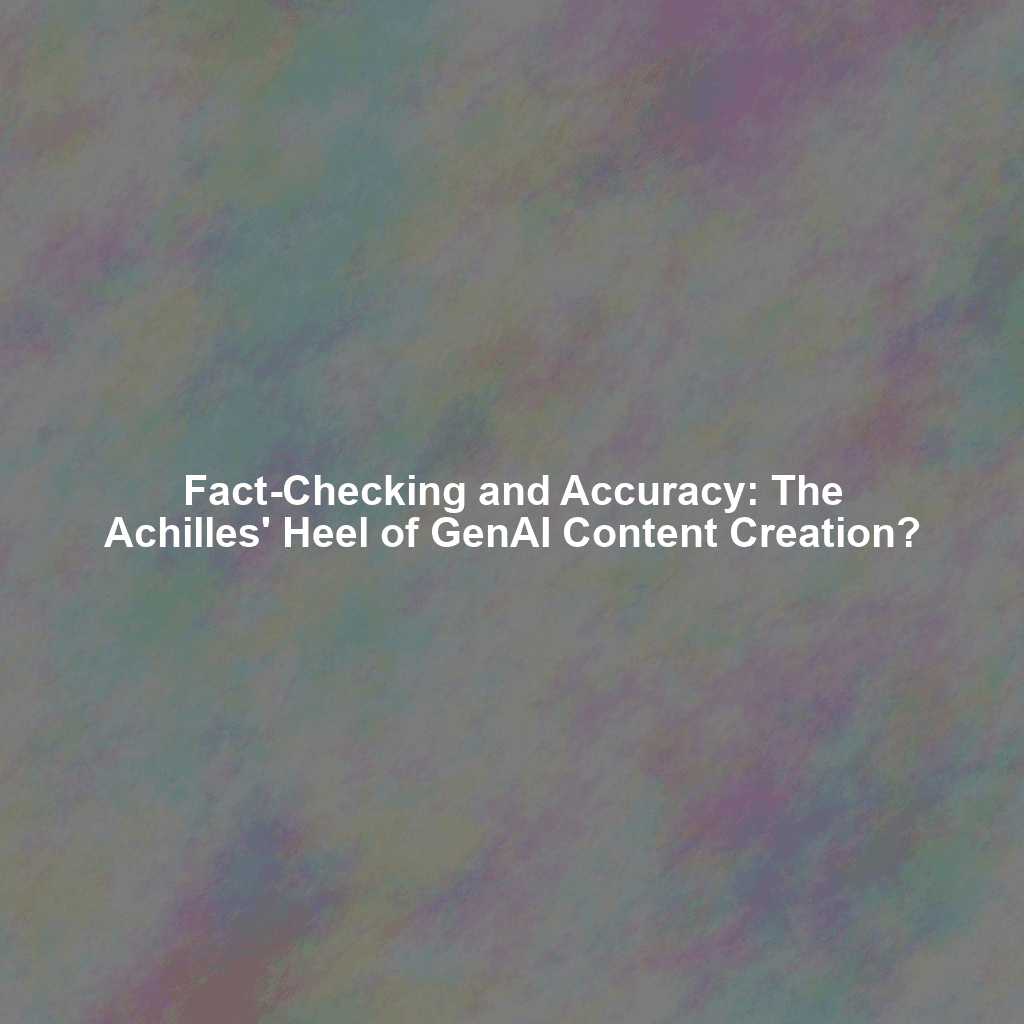Generative AI (GenAI) has revolutionized content creation, offering unprecedented speed and scale. From crafting blog posts to generating marketing copy, its potential seems limitless. However, beneath the surface of impressive text generation lies a critical vulnerability: the accuracy and reliability of the information it produces. While GenAI excels at mimicking human-like writing styles and optimizing for SEO, its dependence on vast datasets without inherent fact-checking mechanisms makes it prone to errors, biases, and even outright fabrication. This article delves into the challenges of accuracy in GenAI content, highlighting the indispensable role of human oversight and robust fact-checking processes.
The Allure and the Risk: Understanding GenAI’s Capabilities
GenAI models are trained on massive datasets scraped from the internet. This allows them to learn patterns, grammar, and stylistic nuances, enabling them to generate seemingly original content on a wide range of topics. The ability to quickly produce drafts, brainstorm ideas, and translate languages is undoubtedly attractive. However, the very nature of this training data introduces inherent risks. If the data contains inaccuracies, biases, or outdated information, the GenAI model will likely perpetuate these flaws in its output.
The “Hallucination” Problem: When AI Makes Things Up
One of the most significant challenges is the phenomenon of “hallucination,” where GenAI confidently presents false or misleading information as fact. This isn’t deliberate deception; rather, it stems from the model’s attempt to create coherent and plausible narratives based on the patterns it has learned. The model might fill in gaps in its knowledge with fabricated details, present outdated information as current, or even invent sources and citations. This can be particularly problematic in fields requiring high accuracy, such as journalism, scientific writing, and legal documentation.
GenAI vs. Human Content Writers: A Quality Comparison
When comparing GenAI-generated content to human-written content, several key differences emerge, particularly regarding accuracy and overall quality.
Accuracy and Fact-Checking: The Human Advantage
Human writers, especially those with expertise in a specific field, bring critical thinking, contextual understanding, and the ability to verify information through reliable sources. They can assess the credibility of sources, identify biases, and synthesize information to create accurate and nuanced content. GenAI, on the other hand, lacks this inherent ability. It relies on statistical probabilities rather than genuine understanding, making it susceptible to errors. A human writer is trained to research and back up claims, GenAI is trained to statistically predict the next word in a sequence based on its training data. A human always trumps this when it comes to accuracy.
Style and Grammar: GenAI’s Strength, with Caveats
GenAI excels at mimicking various writing styles and producing grammatically correct text. It can adapt to different tones and formats with relative ease. However, while the grammar may be flawless, the style can sometimes feel generic or lacking in originality. Furthermore, GenAI may struggle with subtle nuances, humor, or emotional intelligence, which are crucial for engaging readers and building trust. A human touch, with proper editing and oversight, is usually what is needed to take GenAI’s output to the next level.
SEO Optimization: A Shared Skillset, but Human Insight Matters
GenAI can be programmed to optimize content for search engines, incorporating relevant keywords and following SEO best practices. However, effective SEO requires more than just keyword stuffing. It involves understanding user intent, analyzing search trends, and creating content that provides genuine value to readers. Human SEO specialists bring these strategic insights to the table, ensuring that content not only ranks well but also resonates with the target audience. Additionally, as search engines continue to evolve and prioritize E-E-A-T (Experience, Expertise, Authoritativeness, and Trustworthiness), human-generated content with demonstrated expertise and a personal touch will likely hold an advantage.
The Importance of Human Oversight and Fact-Checking
Given the inherent limitations of GenAI in terms of accuracy, human oversight is absolutely essential. This involves a multi-step process that includes:
Verification of Information: Cross-Referencing and Source Evaluation
Every claim made by GenAI should be verified against reliable sources. This includes cross-referencing information, evaluating the credibility of sources, and identifying potential biases. Fact-checkers must be meticulous and detail-oriented, ensuring that the information presented is accurate and up-to-date. They can be fact-checking on a sentence-by-sentence basis, and also look for factual inconsistencies and logic errors within the outputted text.
Bias Detection and Mitigation: Ensuring Fairness and Objectivity
GenAI models can perpetuate biases present in their training data. Human reviewers must be vigilant in detecting and mitigating these biases, ensuring that content is fair, objective, and inclusive. This involves scrutinizing language, identifying potentially discriminatory statements, and adjusting the content to promote neutrality. Often, subtle context is required here – human expertise and domain knowledge is the only way to resolve these issues.
Contextualization and Nuance: Adding Depth and Meaning
While GenAI can generate grammatically correct sentences, it often lacks the contextual understanding and nuance that characterize human writing. Human editors can add depth and meaning to the content, ensuring that it resonates with the target audience and effectively conveys the intended message. A human can also add personal experience or anecdotes to make the article more engaging and interesting.
Conclusion: GenAI as a Tool, Not a Replacement
GenAI offers a powerful tool for content creation, but it should not be viewed as a replacement for human writers. Its strengths lie in speed, scalability, and stylistic versatility, while its weaknesses lie in accuracy, critical thinking, and contextual understanding. By embracing GenAI as a tool and integrating it with robust human oversight and fact-checking processes, we can harness its potential while mitigating its risks. The future of content creation likely involves a collaborative approach, where GenAI assists human writers in producing high-quality, accurate, and engaging content that meets the needs of both readers and search engines. The key is to remember that accuracy is paramount, and human expertise remains indispensable in ensuring the reliability and trustworthiness of information in the digital age.
 Skip to content
Skip to content

